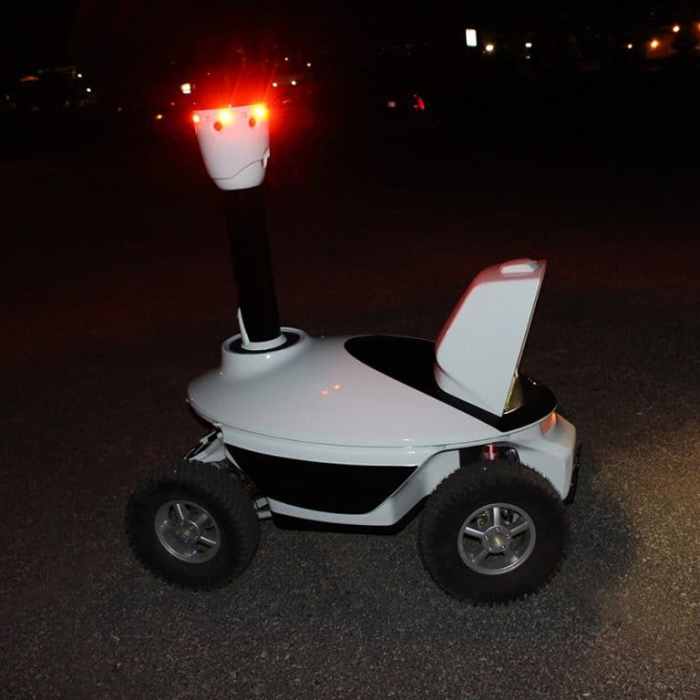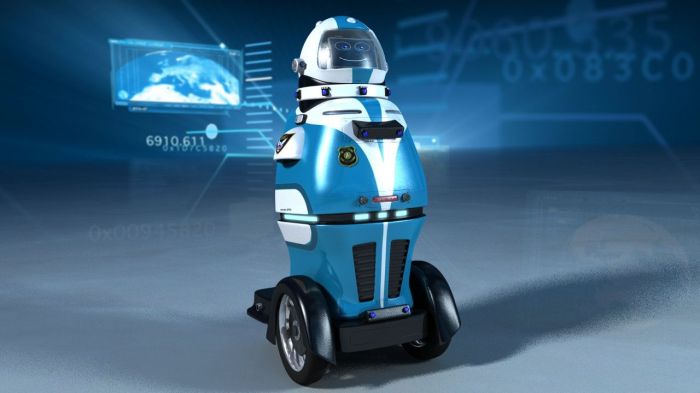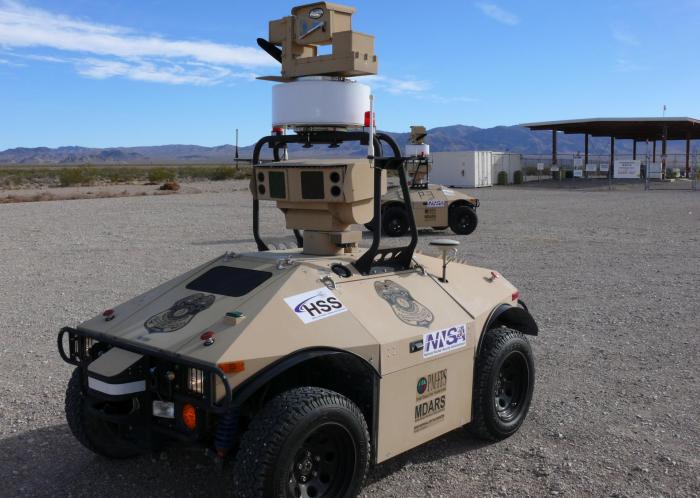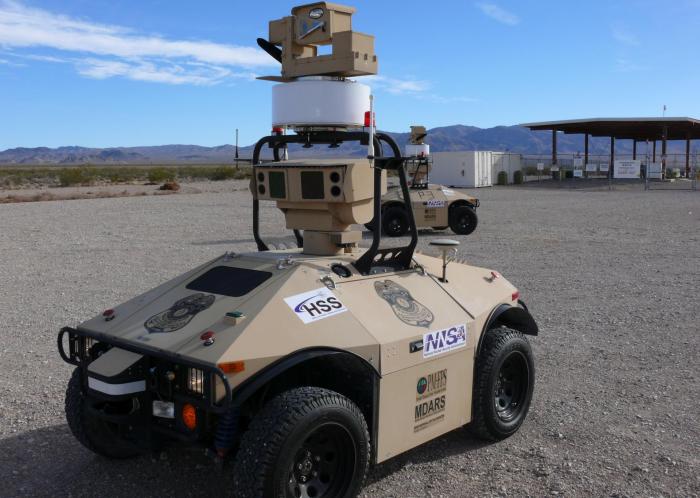Ascento guard patrolling security robot – Ascendo Guard patrolling security robot is not your typical robot; it’s a game-changer in the security industry. This cutting-edge robot is designed to patrol perimeters, monitor sensitive areas, and detect suspicious activity, all while offering a level of security that was previously unimaginable.
Imagine a robot that can tirelessly patrol your property, day and night, without needing breaks or experiencing fatigue. That’s the promise of the Ascendo Guard. Equipped with advanced sensors, including cameras, lidar, and thermal imaging, this robot can detect threats, identify potential intruders, and alert security personnel in real-time.
Its autonomous navigation system allows it to navigate complex environments, avoid obstacles, and adapt to changing conditions.
Introduction to Ascendo Guard Patrolling Security Robot

The Ascendo Guard Patrolling Security Robot is a cutting-edge technological advancement in the realm of security. This autonomous robot is designed to enhance security measures by providing 24/7 surveillance and patrol capabilities. Equipped with advanced sensors, cameras, and artificial intelligence (AI), the Ascendo Guard robot can detect and respond to potential threats, ensuring a safer and more secure environment.The Ascendo Guard Patrolling Security Robot plays a crucial role in the modern security industry by automating routine tasks and enhancing overall security protocols.
Its primary function is to patrol designated areas, monitor for suspicious activity, and alert security personnel in case of any incidents. This allows human security guards to focus on more complex tasks and strategic initiatives, while the robot provides continuous and vigilant monitoring.
Benefits of Utilizing Ascendo Guard Patrolling Security Robots
The implementation of Ascendo Guard robots offers a multitude of benefits for security operations, contributing to a more effective and efficient security system.
- Enhanced Security Presence:The continuous patrol and monitoring capabilities of the robot create a visible and deterring security presence, discouraging potential threats and enhancing the overall security perception of the area.
- Improved Response Time:The Ascendo Guard robot’s ability to detect and alert security personnel in real-time significantly reduces response times to incidents, allowing for faster intervention and potentially preventing escalation.
- Cost Savings:By automating routine patrols and surveillance tasks, the Ascendo Guard robot can help reduce the need for human security guards, leading to cost savings in the long run.
- Increased Efficiency:The robot’s tireless and consistent performance ensures continuous monitoring and surveillance, maximizing security efficiency and minimizing potential gaps in coverage.
- Data Collection and Analysis:The Ascendo Guard robot can collect valuable data from its patrols, including images, videos, and sensor readings. This data can be analyzed to identify patterns, trends, and potential security vulnerabilities, enabling proactive security measures.
Technical Specifications and Capabilities
The Ascendo Guard is designed to be a robust and versatile security robot, capable of operating autonomously in a variety of environments. Its technical specifications and capabilities reflect its advanced design and features, making it an effective tool for enhancing security and surveillance.
Dimensions and Weight
The Ascendo Guard has a compact design, making it suitable for navigating through tight spaces and confined areas. Its dimensions are:
- Height: 1.2 meters
- Width: 0.6 meters
- Depth: 0.5 meters
The robot weighs approximately 50 kilograms, ensuring stability and maneuverability.
Battery Life and Operating Range, Ascento guard patrolling security robot
The Ascendo Guard is powered by a high-capacity lithium-ion battery, providing a long operating range and extended battery life.
- Battery Life: Up to 12 hours on a single charge
- Operating Range: Up to 5 kilometers
The robot’s long battery life and operating range enable continuous surveillance and patrol operations, minimizing downtime and maximizing operational efficiency.
Sensors and Technologies
The Ascendo Guard is equipped with a suite of advanced sensors and technologies, enabling it to perceive its surroundings and navigate effectively.
- Cameras: The robot features multiple high-resolution cameras, providing a wide field of view and detailed imagery. These cameras can capture images and videos in various lighting conditions, including low-light environments.
- Lidar: Light Detection and Ranging (Lidar) technology allows the robot to accurately map its surroundings, creating a 3D representation of the environment. Lidar sensors provide precise distance measurements, enabling the robot to navigate complex environments with high accuracy and avoid obstacles.
- Thermal Imaging: Thermal imaging cameras enable the robot to detect heat signatures, allowing it to identify objects and individuals even in darkness or obscured by smoke or fog. This capability enhances security by detecting potential threats that may not be visible to standard cameras.
Navigation System
The Ascendo Guard utilizes an advanced navigation system that combines autonomous movement and obstacle avoidance capabilities.
- Autonomous Movement: The robot uses pre-programmed patrol routes and intelligent algorithms to navigate autonomously, allowing it to cover vast areas without human intervention.
- Obstacle Avoidance: The Ascendo Guard’s sensors, including Lidar and cameras, enable it to detect and avoid obstacles in its path. The robot can navigate around stationary and moving objects, ensuring safe and efficient movement.
The robot’s navigation system is designed to be robust and reliable, ensuring that it can operate effectively in a variety of environments, including indoor and outdoor spaces.
Security Applications and Use Cases

The Ascendo Guard robot’s advanced capabilities and features make it a valuable asset in various security applications. Its ability to patrol perimeters, monitor sensitive areas, and detect suspicious activity enhances security measures in diverse environments.
Patrolling Perimeters
Patrolling perimeters is a crucial security measure that the Ascendo Guard robot excels at. Its autonomous navigation system enables it to cover large areas efficiently and consistently, reducing the need for human guards. Equipped with sensors and cameras, the robot can detect intrusions, unauthorized access, and potential threats.
For instance, in large industrial complexes, the robot can patrol the perimeter fence, detecting any attempts to breach it and alerting security personnel.
Monitoring Sensitive Areas
The Ascendo Guard robot can be deployed to monitor sensitive areas, such as data centers, research facilities, and high-value assets. Its ability to detect movement, identify individuals, and analyze unusual activity makes it an effective deterrent against theft, vandalism, and other security breaches.
In a data center, the robot can patrol the server rooms, monitoring for unauthorized access, temperature fluctuations, and other potential threats.
Detecting Suspicious Activity
The Ascendo Guard robot’s advanced sensors and AI algorithms enable it to detect suspicious activity, such as unusual movement patterns, unauthorized entry, or potential threats. Its real-time analysis and reporting capabilities allow security personnel to respond quickly and effectively to any incidents.
In a retail store, the robot can monitor customer activity, detect shoplifting attempts, and alert security personnel to potential threats.
Example Applications
- Critical Infrastructure Protection:The Ascendo Guard robot can be deployed to protect critical infrastructure, such as power plants, pipelines, and communication networks. Its ability to patrol perimeters, detect intrusions, and monitor environmental conditions makes it an effective deterrent against sabotage and other security threats.
Expand your understanding about new jobs generative ai future with the sources we offer.
- Airport Security:The robot can be used to patrol airport terminals, baggage claim areas, and other sensitive areas, detecting suspicious activity, monitoring crowd behavior, and assisting security personnel in responding to incidents.
- Campus Security:The Ascendo Guard robot can enhance campus security by patrolling dormitories, parking lots, and other areas, detecting unauthorized access, monitoring student activity, and responding to emergency situations.
- Construction Sites:The robot can be deployed to monitor construction sites, detecting unauthorized access, preventing theft of materials, and ensuring the safety of workers.
Advantages and Disadvantages of Using Security Robots: Ascento Guard Patrolling Security Robot
The integration of security robots into various environments is becoming increasingly common, promising enhanced security and operational efficiency. However, it’s crucial to understand the potential advantages and disadvantages of deploying these technological solutions before making any decisions.
Cost Savings
Security robots can significantly reduce labor costs compared to traditional security personnel. They can operate autonomously for extended periods, eliminating the need for human guards to work shifts. This can lead to substantial savings in salaries, benefits, and overtime pay.
Improved Efficiency
Security robots are equipped with advanced sensors and cameras that allow them to monitor large areas with greater accuracy and speed than humans. They can detect potential threats, such as intruders or suspicious activity, and alert security personnel in real-time.
This increased efficiency can improve response times and minimize the risk of security breaches.
Enhanced Security
Security robots can be deployed in hazardous or challenging environments where human security guards might face risks. They can patrol perimeters, detect fires, and even assist with crowd control. Their presence can act as a deterrent to potential criminals, reducing the likelihood of incidents.
Disadvantages of Using Security Robots
While security robots offer numerous advantages, it’s important to consider their potential drawbacks.
Limitations in Certain Situations
Security robots may struggle to navigate complex or dynamic environments, such as crowded areas or spaces with obstacles. They may also have difficulty identifying subtle cues or interpreting complex situations that humans can readily understand.
Ethical Considerations
The use of security robots raises ethical concerns about privacy, data security, and the potential for bias in decision-making algorithms. It’s crucial to ensure that robots are deployed responsibly and that appropriate safeguards are in place to protect individuals’ rights.
Potential Risks
Security robots are susceptible to hacking and manipulation, which could compromise their security functions. There’s also a risk of robots malfunctioning or causing unintentional damage. It’s important to have robust safety protocols and contingency plans in place to mitigate these risks.
Comparison to Traditional Security Methods
Security robots offer advantages over traditional security methods, such as reduced costs, improved efficiency, and enhanced security. However, they also have limitations, such as difficulty navigating complex environments and ethical concerns.
Advantages of Traditional Security Methods
Traditional security methods, such as human guards, offer advantages in terms of adaptability, situational awareness, and interpersonal skills. Human guards can respond to unexpected situations and make complex decisions based on their experience and judgment.
Disadvantages of Traditional Security Methods
Traditional security methods can be costly, prone to human error, and require constant supervision. They may also be less effective in deterring crime or responding to threats in remote or challenging environments.
Future Developments and Trends in Security Robotics

The field of security robotics is rapidly evolving, driven by advancements in artificial intelligence (AI), sensor technology, and robotics. These developments are poised to transform the way security is approached and implemented, with significant implications for the future of security robots.
Enhanced AI Capabilities
The integration of advanced AI algorithms is revolutionizing security robots, enabling them to perform tasks with greater autonomy and intelligence. This includes:* Improved Object Recognition:AI-powered robots can now recognize and identify objects with greater accuracy, including suspicious items, unauthorized personnel, and potential threats.
This enhanced object recognition capability allows for more proactive threat detection and response.
Predictive Analytics
AI algorithms can analyze data from various sources, such as sensor readings, historical data, and environmental conditions, to predict potential security risks. This predictive capability allows for proactive measures to be taken, reducing the likelihood of incidents.
Adaptive Learning
AI-enabled robots can learn and adapt to changing environments and security threats. This adaptive learning capability ensures that robots remain effective in dynamic situations and can respond effectively to new challenges.
Human-Robot Collaboration
AI is facilitating seamless collaboration between security robots and human security personnel. Robots can provide real-time information, alerts, and situational awareness, allowing human operators to make more informed decisions and optimize their response strategies.
Increased Autonomy
Security robots are becoming increasingly autonomous, capable of operating with minimal human intervention. This increased autonomy is achieved through:* Advanced Navigation Systems:Robots are equipped with sophisticated navigation systems, including GPS, LiDAR, and SLAM (Simultaneous Localization and Mapping) technologies. These systems enable robots to navigate complex environments, avoid obstacles, and follow predefined patrol routes.
Self-Charging Capabilities
Robots are now equipped with self-charging capabilities, allowing them to autonomously recharge their batteries when needed. This eliminates the need for manual intervention and ensures continuous operation.
Remote Control and Monitoring
Security robots can be remotely controlled and monitored from a central command center. This allows security personnel to oversee operations, adjust patrol routes, and intervene in real-time if necessary.
Integration with Other Security Systems
Security robots are being integrated with other security systems to create a comprehensive and interconnected security ecosystem. This includes:* Integration with Access Control Systems:Robots can interact with access control systems, verifying identities, granting or denying access, and monitoring authorized entry and exit points.
Integration with Surveillance Systems
Robots can be integrated with surveillance cameras and other sensors, providing real-time situational awareness and enabling remote monitoring of critical areas.
Integration with Alarm Systems
Robots can be connected to alarm systems, responding to alerts and initiating appropriate actions, such as deploying additional security measures or notifying human personnel.
Impact on the Security Industry
These advancements in security robotics are transforming the security industry in several ways:* Enhanced Security Effectiveness:Robots can patrol areas more effectively and efficiently than humans, providing continuous surveillance and detecting potential threats.
Cost Savings
Robots can reduce the need for human security personnel, leading to significant cost savings for organizations.
Improved Response Times
Robots can respond to incidents more quickly than humans, reducing response times and minimizing damage.
Increased Security Awareness
Robots can act as a deterrent to crime, as their presence alone can discourage criminal activity.
Security robotics is poised to revolutionize the security industry, offering a new era of enhanced security, cost-effectiveness, and technological innovation.
Ethical Considerations and Societal Impact
The integration of security robots into our daily lives raises crucial ethical questions and prompts considerations about their societal impact. As these machines become more sophisticated and prevalent, it is imperative to address the potential ramifications of their widespread adoption.
Privacy Concerns
The use of security robots raises significant concerns about privacy. These robots are equipped with advanced sensors, cameras, and data processing capabilities, enabling them to collect vast amounts of personal information. The potential for misuse of this data, such as unauthorized surveillance, data breaches, or the creation of intrusive facial recognition databases, necessitates stringent regulations and ethical guidelines to protect individual privacy.
Potential for Misuse
While security robots are designed to enhance safety and security, their potential for misuse cannot be ignored. The possibility of these robots being programmed to discriminate against certain individuals or groups, or being hacked and used for malicious purposes, requires careful consideration.
Robust security measures, ethical frameworks, and responsible deployment practices are crucial to mitigate these risks.
Job Displacement
The increasing adoption of security robots is likely to have a significant impact on the job market, potentially leading to job displacement in the security sector. While these robots can automate certain tasks, they also create new opportunities in fields such as robotics engineering, data analysis, and cybersecurity.
Addressing the potential for job displacement requires proactive measures, such as retraining programs and social safety nets, to ensure a smooth transition for workers impacted by automation.
Changes in Security Practices
The widespread adoption of security robots is likely to lead to significant changes in security practices. For example, the use of robots for perimeter patrol, crowd control, and incident response could enhance security effectiveness and reduce reliance on human guards.
However, it is essential to ensure that these changes are implemented in a way that maintains human oversight and accountability.
Public Perception
Public perception of security robots is evolving. Some individuals may view these robots as a welcome addition to security systems, providing increased safety and peace of mind. Others may harbor concerns about their potential for misuse, job displacement, or the erosion of human interaction.
It is crucial to engage in open dialogue and public education to foster understanding and address concerns about the use of robots in security.
Importance of Responsible Development and Deployment
The ethical considerations surrounding the use of security robots highlight the importance of responsible development and deployment. This includes:
- Establishing clear ethical guidelines and principles for the design, development, and deployment of security robots.
- Ensuring transparency and accountability in the use of these robots, with clear protocols for data collection, storage, and access.
- Promoting collaboration between technology developers, policymakers, and stakeholders to address ethical concerns and ensure responsible use.


